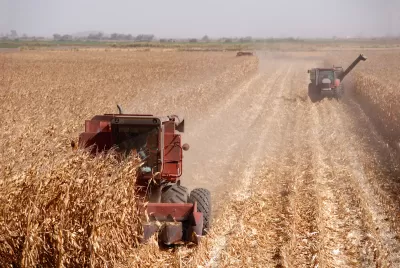The San Joaquin Valley has some of the worst air pollution and particulate matter emissions in the nation, but agricultural sources are loosely regulated.

California’s most intensively farmed counties don’t pass the EPA’s newest standards for particulate matter, reports Virginia Gewin in Civil Eats. Some are not even close to reaching the prior target established in 2012. “Agriculture’s contribution to PM2.5 stems from burning, soil management, and gaseous emissions from both tractors and soil,” Gewin explains.
“The San Joaquin Valley is the largest agricultural producing area in the nation; it produced crops, livestock, and agricultural commodities worth $36.5 billion in 2022. The southern half of California’s 450-mile Central Valley is also home to some of the worst annual air pollution in the nation. Mountain ranges trap emissions from highway traffic, locomotives, municipal composting facilities, tractors, and burning.”
The article details steps the district is taking to reduce emissions and improve air quality in the regions, but critics say the regulations don’t go far enough in the agricultural sector. For example, agricultural tractors are not regulated by CARB, despite being a major source of emissions. Meanwhile, water restrictions will force farmers to leave hundreds of thousands of acres of farmland fallow, which could generate more dust.
FULL STORY: California Farm Counties Are Not Even Close to Meeting the EPA’s New Clean Air Quality Standard

Alabama: Trump Terminates Settlements for Black Communities Harmed By Raw Sewage
Trump deemed the landmark civil rights agreement “illegal DEI and environmental justice policy.”

Study: Maui’s Plan to Convert Vacation Rentals to Long-Term Housing Could Cause Nearly $1 Billion Economic Loss
The plan would reduce visitor accommodation by 25% resulting in 1,900 jobs lost.

Why Should We Subsidize Public Transportation?
Many public transit agencies face financial stress due to rising costs, declining fare revenue, and declining subsidies. Transit advocates must provide a strong business case for increasing public transit funding.

Wind Energy on the Rise Despite Federal Policy Reversal
The Trump administration is revoking federal support for renewable energy, but demand for new projects continues unabated.

Passengers Flock to Caltrain After Electrification
The new electric trains are running faster and more reliably, leading to strong ridership growth on the Bay Area rail system.

Texas Churches Rally Behind ‘Yes in God’s Back Yard’ Legislation
Religious leaders want the state to reduce zoning regulations to streamline leasing church-owned land to housing developers.
Urban Design for Planners 1: Software Tools
This six-course series explores essential urban design concepts using open source software and equips planners with the tools they need to participate fully in the urban design process.
Planning for Universal Design
Learn the tools for implementing Universal Design in planning regulations.
Caltrans
Smith Gee Studio
Institute for Housing and Urban Development Studies (IHS)
City of Grandview
Harvard GSD Executive Education
Toledo-Lucas County Plan Commissions
Salt Lake City
NYU Wagner Graduate School of Public Service



























